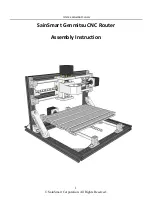
66
• Using
Auto Acceptance,
the base station automatically accepts the sub station.
• Using
Manual Acceptance
, you must manually accept each sub station by
enabling the
Accept Status
field (in “1.2.3.1.4 ADP Substation Configuration” on
page 81) for that
Sub Station Number
.
Disabling ADP
When configuring the base station, you may choose to disable ADP, which can result in
reduced overhead. If you disable ADP, you must manually assign the base sub ports for
the sub stations by using 1.2.3.1.3 RF Base Sub Port Configuration, described in detail on
page 80. to enter the
Sub-Station Number
and
IP address
information. On the sub station,
you must also manually set up the RF sub ports, entering in the same
Sub-Station Number
in “1.2.3.1.2 RF Sub Port Configuration” on page 78.
If ADP is disabled, the ADP polling operation does not apply (see “ADP Discovery Pro-
ADP Discovery Process
The discovery process is as follows when ADP is enabled:
• The base station is not yet aware of the sub station, and the sub station is waiting
for an ADP request from the base. The base station sends out a broadcast
request at the broadcast address of 255.
• The sub station replies to the broadcast with its IP address.
• The base station sends another broadcast to assign the station address (Sub-s
ta-
tion Number
). The base station assigns the next available address to the sub sta-
tion. This is the base sub port address for the sub station in the range of 256 to
512.
• The base station can now communicate with the sub station using RF-DLC
frames:
Summary of Contents for skyway series
Page 12: ...x ...
Page 26: ...xxiv Index 229 ...
Page 52: ...26 ...
Page 66: ...40 ...
Page 82: ...56 ...
Page 150: ...124 ...
Page 196: ...Status Summary 170 ...
Page 214: ...188 ...
Page 218: ...192 ...
Page 222: ...196 ...
Page 238: ...212 ...
Page 254: ...228 ...
















































